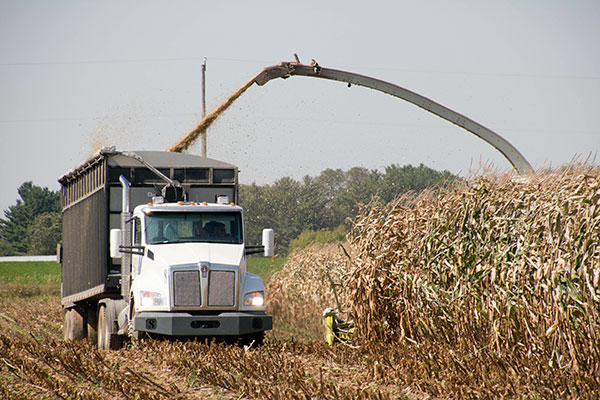It’s how dry? |
| By Mike Rankin, Managing Editor |
|
|
 Through the years, farmers have devised any number of methods to estimate the moisture of cut forage in an attempt to hit the optimum harvest mark. Forgoing the Koster Tester or microwave, I’ve seen farmers ball up wilting hay in their hands, chew on stems, feel, smell, and otherwise mutilate a windrow in an attempt to gauge moisture content. Truthfully, I’ve done it myself. Why? Because optimum moisture is critical for proper storage and to optimize forage quality. Corn silage, however, is a different animal. Moisture content must be gauged on the hoof, so to speak. Additionally, short of an orangutan, crumpling a corn plant in the palm of your hand isn’t an option. Harvest moisture content for corn silage is every bit as important as cut and wilted forage crops. Maybe more so. Corn silage that is too wet is prone to silo seepage and nutrient loss, yields less per acre, has lower starch content, and is prone to fermentation problems. Chopping too dry results in drier grain with harder kernels; more, but perhaps less digestible starch; a lower concentration of sugars; less digestible fiber; and potential packing or fermentation issues. Miss the proper harvest moisture and everything that was done right for the previous four months can be compromised. Pegging the moisture content may be even more difficult in 2016 if you’re in an area embroiled with hot, dry weather. Corn silage is complicated. There is both a grain component that accounts for 50 percent of the dry matter and a stover component, which can further be broken down into stalk, leaves, cob, and husks. All contain moisture, but at different levels and at different loss rates. As a general rule, whole plant corn moisture drops about 0.5 percent per day as the plant pushes to maturity from dough to black layer stages. That can vary significantly depending on environmental conditions, especially dry soils. This may be a year to start monitoring whole plant moisture earlier than normal, even if the plant looks relatively green and healthy. In a recent Purdue University Pest & Crop Newsletter, Bob Nielsen, extension corn agronomist, notes, “Warmer temperatures from pollination to kernel maturity increase the calendar rate of crop development (how fast the crop moves through the grain filling stages). Consequently, the number of days in the grain fill period decreases and kernel maturity occurs earlier with warmer temperatures than with cooler temperatures.” Couple dry soil conditions with heat and it’s likely the optimum whole-plant moisture may be reached earlier than expected. Again, grain is 50 percent of the dry matter. While it is important to realize the effect that heat and dry conditions have on maturity and whole plant moisture, it is also true that corn plants can rehydrate following a significant rain event. In a Wisconsin study, dry corn that was located on a knoll rehydrated nearly 15 percent following a heavy rain event; however, it returned to its original moisture content after three days. That’s not a long window of opportunity if you need to add moisture; it’s also a situation when there may be a higher risk for elevated levels of nitrate. So, how does a person know when corn has reached the optimum whole plant moisture for harvesting? This still remains the weakest link in the corn silage management chain; there is no easy way to estimate plant moisture by simply eyeballing the plant. Kernel milk line was once thought to be the answer, but hybrid variation has disposed with that criterion for all but as a means to trigger more rigorous and precise methods of moisture estimation. In some areas, corn silage “dry down” events are offered. Whole plants are cut from the field and run through a landscape-type chipper-shredder. The samples are then microwaved or sent to a lab for moisture determination. Such efforts have proven popular and effective but are not without the inherent errors that go along with limited sample size and testing procedures. They do, however, help to prevent major misjudgments of whole plant moisture caused by environmental conditions or hybrid phenotype. Finally, keep in mind that whole-plant moisture can be affected by cutting height. Cutting low will tend to raise moisture concentrations but lower overall forage quality; cutting high will lower the moisture but elevates quality. In one Wisconsin study, whole-plant moisture fell 3 to 4 percent as cutting height was raised from 6 to 18 inches. In this, a year with more than the usual number of acres beset by dry conditions across major corn silage production regions, make sure you know the status of milkline progression. Once it has moved one-quarter to one-third of the way down the kernel, begin monitoring whole plant moisture. After it’s in the silo, you don’t want to be saying, “It’s how dry?” — or perhaps something worse.
|
